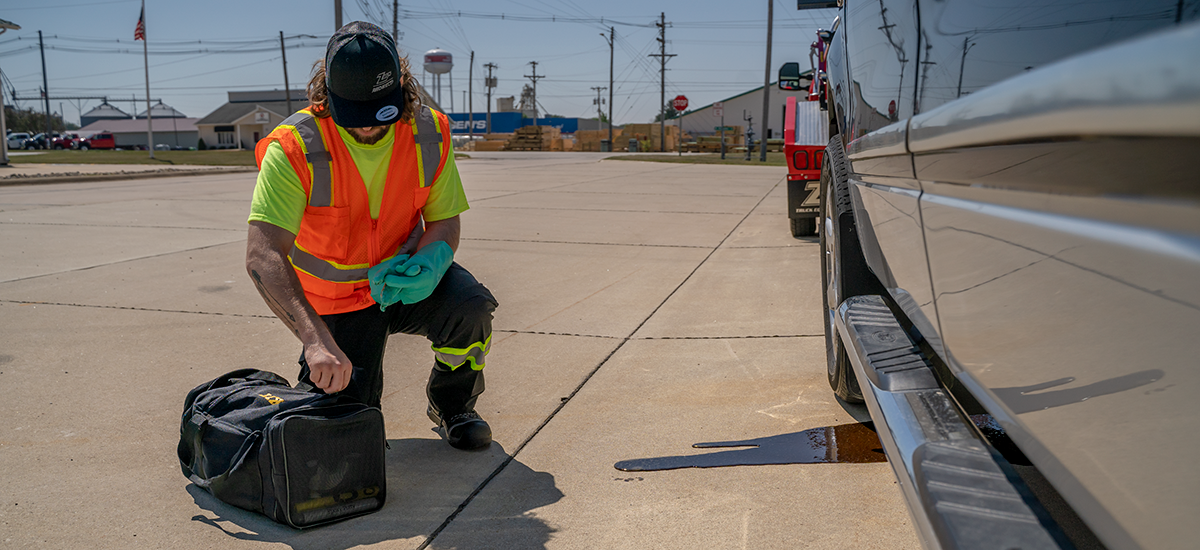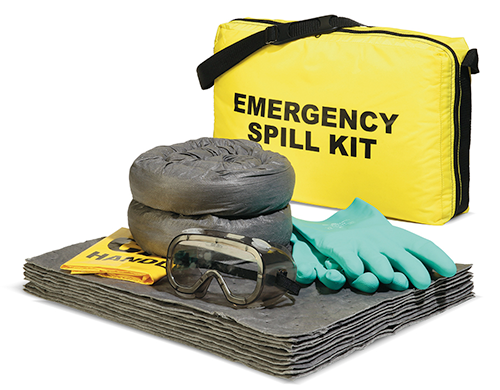
A 55-gallon drum spill pierced by a forklift driver. A 150-gallon fuel tank punctured in an accident. An oil drain pan knocked over during a routine service.
Unexpected leaks, spills and messes happen. How quickly you respond and how effective the cleanup is can make a difference in the following areas:
- Personal safety by eliminating fumes and slippery surfaces
- Environmental protection by controlling hazardous material spills
- Property preservation by preventing long-term damage
Some spills are benign. Others caustic. Employees should be trained on the types and hazards of fluids they work around or could perhaps encounter during their workshift.
For example, a tow operator should know how to treat fuel and coolant leaks. A machinist should know how to address cutting oil on the floor and a mechanic should know what materials absorb oil best.
Several federal regulatory agencies, including the EPA, OSHA and DOT, set certain standards for spill handling and reporting. States may have additional requirements, and reporting can be as simple as contacting the
National Response Center at (800) 424-8802. For example, a diesel fuel spill in excess of 25 gallons is considered a “reportable quantity,” or RQ while some may require an emergency response.
According to the EPA, “any person or organization responsible for a release or spill is required to notify the federal government when the amount reaches a federally-determined limit.” For complete details and reporting requirements, visit the
EPA’s website here.
 Additionally, companies and fleets should have spill response kits easily accessible in case of emergencies. These kits can be as small as a fork-lifted mounted bag or as large as a wheeled 95-gallon overpack drum.
Additionally, companies and fleets should have spill response kits easily accessible in case of emergencies. These kits can be as small as a fork-lifted mounted bag or as large as a wheeled 95-gallon overpack drum.
Types of Spill kit contents can vary depending on the size of the spill area and type of spill. The size required typically depends on the risk for exposure. To small or large spills, but each kit should include the following provisions
- Personal protective equipment, such as gloves, boots and safety glasses
- Containment products, like absorbent mats, booms, socks and pillows
- Disposal bags to properly collect and identify soiled materials
- Cautionary signs to warn others of the spill and cleanup underway
To keep a leak from escalating and reaching environmentally-sensitive areas, drains should be covered inside buildings. Outside, temporary dikes and berms should be created to prevent undesirable fluids from reaching storm sewers, creeks, ditches and other nearby waterways. Most containment products work in unison to accommodate any size situation.

It is important to note absorbent materials are available in a variety of compositions and grades. Granular absorbents, such as floor dry or vermiculite, are perhaps the most common method for treating spills and improving traction on slippery surfaces. Polypropylene materials are gaining in popularity and create less mess afterwards.
Here are three general types of non-granular absorbent materials:
- Universal to address a combination of chemical and water-based fluids
- Oil-only to absorb petroleum-based leaks and spills
- Hazmat to handle dangerous situations, such as battery acid
Whatever materials you choose, you want to soak up as much fluids as possible in a timely manner. The longer the undesirable fluid remains on the ground, the greater the risk for unwanted contamination, personal injury and property damage. For instance, coolant, fuel and oil spills at an accident scene can potentially degrade the road surface.
Whenever possible, the source of the leak should be identified to keep the containment area from spreading. Place booms and socks around the leak, and if the cause is a hole or seam failure, use epoxy sticks and wooden plugs to patch the compromised area.
Try to confine the remaining fluids to the original container and properly dispose of soiled materials afterwards.
The goal with any spill or leak is to contain it as safely and quickly as possible. Nobody expects to deal with a mess when they start their work day.
Employees should have a plan in place for the time one happens. Companies should not only invest in employee training but also in the adequate absorbent materials. This allows them to be ready to respond when a spill occurs.